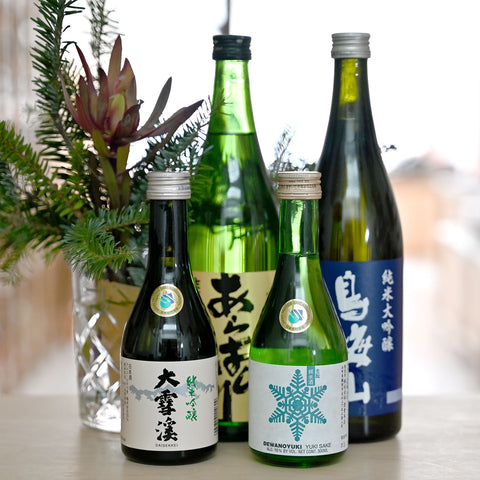
Visiting President Chobei Yamamoto at Yucho Shuzo in Gose City was one of the most educational brewery visits I’ve ever experienced. He invited me into his meeting room, where he had piles of very old books on Nara’s history and sake-making. He eagerly pointed out obscure passages that hinted at how monks were making sake back in the 1400s. Yamamoto-san studies history to build upon it.
 President of Yucho Shuzo, Chobei Yamamoto showing passages in old texts about sake-making.
President of Yucho Shuzo, Chobei Yamamoto showing passages in old texts about sake-making.
 Old journal about sake making in Nara.
Old journal about sake making in Nara.
 Diagram showing the layout of the sake production site in old Nara.
Diagram showing the layout of the sake production site in old Nara.
One of Yamamoto-san's latest projects entitled Mizuhana takes two recipes from these old texts and recreates them. He has created two bottles under the Mizuhana line so far: 1335 and 1568. They are named after the years the recipes were penned.
To recreate these recipes, he ferments the sake in kame (clay pots) that his team build by hand in the warehouse. He says that they only use resources that would have been available at the time the recipes were used.
He explained to me that he thinks of sake-making as “layering techniques.” That is to say, you can control flavors and aroma with techniques like bodaimoto, skipping pasteurization, filtration, or dilution.
 Yucho Shuzo brewery workers making a kame (clay pot) for sake fermentation.
Yucho Shuzo brewery workers making a kame (clay pot) for sake fermentation.
 Yamamoto-san showing us how small these pots are in comparison to the tanks that are used now.
Yamamoto-san showing us how small these pots are in comparison to the tanks that are used now.
 Yamamoto-san refurbished the dusty old attic of the brewery into a gleaming new space to ferment Mizuhana sakes.
Yamamoto-san refurbished the dusty old attic of the brewery into a gleaming new space to ferment Mizuhana sakes.
 Mizuhana noren (cloth banner).
Mizuhana noren (cloth banner).
 The two Mizuhana bottles named after the year of their respective recipes, 1335 and 1568.
The two Mizuhana bottles named after the year of their respective recipes, 1335 and 1568.
I was fortunate enough to meet Haruna Nakagawa, the master brewer of Kaze no Mori.

Kaze no Mori sakes are one of the most popular sakes we sell at Umami Mart. They are fruity, vibrant, and effervescent. Nakagawa told me that she started at Yucho Shuzo at an entry level position and eventually became the head brewer for Kaze. She likes that the brewery isn't so focused on hierarchy and enjoys the creative freedom she can exercise.

For the Kaze No Mori line, she uses nitrogen at bottling and uses hard water that is obtained by drilling down 100 meters. The nitrogen lends an effervescent layer to the sake, while the hard water (with high mineral content) allows for Kaze No Mori sakes to have their signature rich texture.
 Boxes of Kaze no Mori being shipped out.
Boxes of Kaze no Mori being shipped out.
 Kaze no Mori forklift.
Kaze no Mori forklift.
Finally, I was able to visit their newest facility, Yamato Distillery. This is where they are distilling Kikka Gin.
 Yamato Distillery at Yucho Shuzo.
Yamato Distillery at Yucho Shuzo.
 Column stills at Yamato Distillery.
Column stills at Yamato Distillery.
 Head distiller, Naoki Itadoko, at Yamato Distillery.
Head distiller, Naoki Itadoko, at Yamato Distillery.

 Yomogi (Japanese mugwort) is used as a botanical in Kikka Gin.
Yomogi (Japanese mugwort) is used as a botanical in Kikka Gin.
It was a true honor to be able to meet Yamamoto-san, Nakagawa-san, and Itadoko-san. I learned so much and felt very inspired by all the creativity and attention to history that goes into all of their products.
 From L-R: Haruna Nakagawa, me, and Chobei Yamamoto
From L-R: Haruna Nakagawa, me, and Chobei Yamamoto
We can't wait to get the Mizuhana and Kikka Gin stateside!




Comments (1)
Beautifully explained, thanks for the insight! Can’t wait to try that gin.